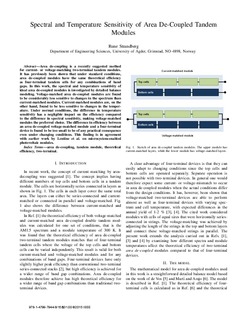| dc.description.abstract | Area de-coupling is a recently suggested method
for current- or voltage-matching two-terminal tandem modules.
It has previously been shown that under standard conditions,
area de-coupled modules have the same theoretical efficiency
as four-terminal tandem cells for any combinations of band
gaps. In this work, the spectral and temperature sensitivity of
ideal area de-coupled modules is investigated by detailed balance
modeling. Voltage-matched area de-coupled modules are found
to be considerably less sensitive to changes in the spectrum than
current-matched modules. Current-matched modules are, on the
other hand, found to be less sensitive to changes in the temperature.
Under normal conditions, the difference in temperature
sensitivity has a negligible impact on the efficiency compared
to the difference in spectral sensitivity, making voltage-matched
modules the preferred choice. The difference in efficiency between
an area de-coupled voltage-matched module and a four-terminal
device is found to be too small to be of any practical consequence
even under changing conditions. This finding is in agreement
with earlier work by Lentine et al. on microsystem-enabled
photovoltaic modules.
g | nb_NO |
